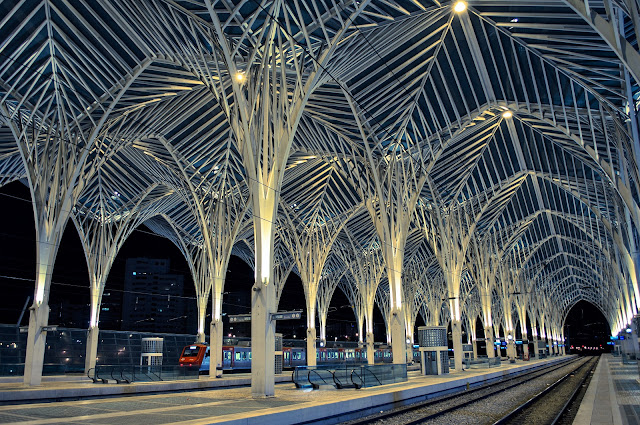LISBON OCEANARIUM
The Lisbon Oceanarium is, by far, one of the top attractions in the capital of Portugal. It is located in the splendid Parque das Nacoes, and despite the fact it does not enjoy the historical prestige of other landmarks of Lisbon, such as the Belem Tower or the Jeronimos Monastery, it remains one of the first-hand must-visits of the city.
The visiting card of the Lisbon Oceanarium opens with a remarkable reference: the venue is one of the largest of its kind in Europe. But it’s not just the dimension which recommends the Oceanarium as a top tourist sight. We also speak of the way it was designed. Indeed, the Lisbon Oceanarium is one of the most paradigmatic works of Peter Chermayeff the company of which is renowned for its proficiency and excellence in the field of aquarium design.
Both by force of its size and of its design, the Lisbon Oceanarium gives visitors the opportunity to learn a lost about the marine life in sundry oceanic habitats. The venue shelters some 450 species, counting thousands of specimens, and reproduces a wide range of habitats, from the tropical Indian coral reefs to the Antarctic coast. In spite of the fact the animal life asset is as impressive as it gets, the Oceanarium has often been criticized for reuniting, in an artificial manner, species which otherwise, in their natural environment, would not blend in together into the same picture, thus distorting the understanding one might get about the sea life.
The Lisbon Oceanarium is also home to impressive interactive displays which inform visitors about the history and the development of the marine world. Stimulating admission discounts are granted to Lisbon Card holders.
Name:
Lisbon Oceanarium (Oceanario de Lisboa)
Address:
Esplanada D Carlos I, Lisbon, Portugal
Telephone:
00351 218 917002
Fax:
00351 218 955762
Website:
CABO RUIVO MARITIME AIRPORT
Cabo Ruivo Seaplane Base was an international airport for seaplanes located in the city of Lisbon, the capital of Portugal. It takes its name from the Lisbon neighbourhood of Cabo Ruivo. The airport was, especially throughout the Second World War, a major gateway and escape route for intercontinental airtravel.
The US intercontinental airline Pan American World Airways, which was a major promoter of the airport's construction, used the airport as a hub for its transatlantic flights until 1945.
The first scheduled commercial passenger flight, from Port Washington, landed on 29 June 1939 on the water airstrip of the Cabo Ruivo Seaplane Base. This Atlantic flight from New York to Lisbon was operated by a Boeing 314 "Dixie Clipper" of Pan American World Airways, with 22 passengers and 11 crew members on board.
During World War II, the transatlantic clippers provided an escape route for refugees from Continental Europe, taking advantage of Portugal's neutral stance in the war.
Accidents and incidents
On 22 February 1943, the Yankee Clipper seaplane of Pan American World Airways was destroyed in a crash while landing on the Tagus River. 24 of the 39 occupants were killed. In 1958, a Martin PBM-5 Mariner crashed on an outbound flight to Madeira, about an hour after taking off from Cabo Ruivo.
PARK OF NATIONS
(PARQUE DAS NAÇÕES)
The Nations Park, widely known even to English speaking visitors as Parque das Nacoes, is not a garden proper, but rather an area of Lisbon. The area was dramatically transformed in the late 20th century in view of accommodating the events and exhibitions occasioned by the Expo’98 World Exhibition, such that at present the Nations Park is one of the most exquisite places where tourists can spend time in Lisbon.
The Nations Park, widely known even to English speaking visitors as Parque das Nacoes, is not a garden proper, but rather an area of Lisbon. The area was dramatically transformed in the late 20th century in view of accommodating the events and exhibitions occasioned by the Expo’98 World Exhibition, such that at present the Nations Park is one of the most exquisite places where tourists can spend time in Lisbon.
The area stretches in the very proximity of the Tagus Estuary, and the facelift required by the said World Exhibition had the effect of turning the former industrial area into one of the most prized residential, leisure and commercial hotspots in Lisbon, but not at the expense of the nature patrimony. Thus, for instance, tourists can stroll around in a set pegged out by tall trees and scenic lakes, as well as they can go bird watching, since the Tagus Estuary, one of the largest estuaries in Europe, is home to a wholesome habitat for plenty of species of birds.
But on top of the nature patrimony, there is an entire leisure infrastructure one can explore at ease: bars, cafes, restaurants, shopping centers (such as the Vasco da Gama Shopping Center), sports opportunities (bike rental is at hand in Parque das Nacoes). Plenty of events are also organized here, but in terms of tourist sights, two of the top alternatives refer to the Pavilion of Knowledge (with its highly interactive programs suggested to the visiting public) and to the splendid Oceanarium, one of the biggest of its kind in Europe.
The presence of the Parque das Nacoes Marina within the park adds to the list of leisure and commercial opportunities available in the area, opening new prospects for tourists who want to search out in depth the surroundings of Lisbon.
Name:
Nations Park (Parque das Nacoes)
Address:
Avenue Joao II, Lisbon, Portugal
SHOPPING CENTER VASCO DA GAMA
With water flowing over the glass roof, this is the most attractive Lisbon mall.
It's especially popular on weekends when families go to the Oceanarium and other attractions nearby, while teens are the majority whenever there's a concert at Meo Arena.
The multiplex cinema is another attraction, as is the huge Continente hypermarket. Other popular stores include FNAC for books and music, and a large Zara for men and women's fashions.
In total there are over 150 shops plus a food court, as well as a pleasant deck on the upper floor overlooking the waterfront.
ORIENTE STATION
( GARE DO ORIENTE)
The Gare do Oriente is a major train, bus and metro station located in eastern Lisbon that provides travel connections to the whole of Portugal. The complex is a modern, well designed station that is safe, clean and hassle free to travel from. The station was constructed as a center piece for Expo 98 and the striking ultra-modern design means that the station is a notable tourist attraction in conjunction with the Parque das Nações. This guide will provide an overview of the Gare do Oriente station, the services that depart from here and tourist information details.
ORIENTE TRAIN STATION
Trains from Lisbon to Porto, Coimbra, Braga, Madrid, Paris.
Trains to Sintra and Cascais/Estoril do not depart from Gare do Oriente they depart from Rossio station (for Sintra) and Cais do Sodré (for Cascais). Most intercity train services for Lisbon stop at both Gare do Oriente and Santa Apolonia station (always check train schedule). Santa Apolonia station is more convenient for visitors who are based in downtown Lisbon (Baixa, Alfama and Bairro Alto district
METRO STATION "ORIENTE"
The Vasco da Gama Bridge (Portuguese: Ponte Vasco da Gama) is a cable-stayed bridge flanked by viaducts and rangeviews that spans the Tagus River in Parque das Nações in Lisbon, the capital of Portugal
It is the longest bridge in Europe (including viaducts), with a total length of 12.3 kilometres (7.6 mi), including 0.8 kilometres (0.50 mi) for the main bridge and 11.5 kilometres (7.1 mi) in viaducts. The Bridge is served by 4.8 kilometres (3.0 mi) of dedicated access roads. It was built with the purpose of alleviating the congestion on Lisbon's other bridge (25 de Abril Bridge) and preventing that traffic travelling between the North and South of the country had to pass through the city of Lisbon.











































































































No comments:
Post a Comment